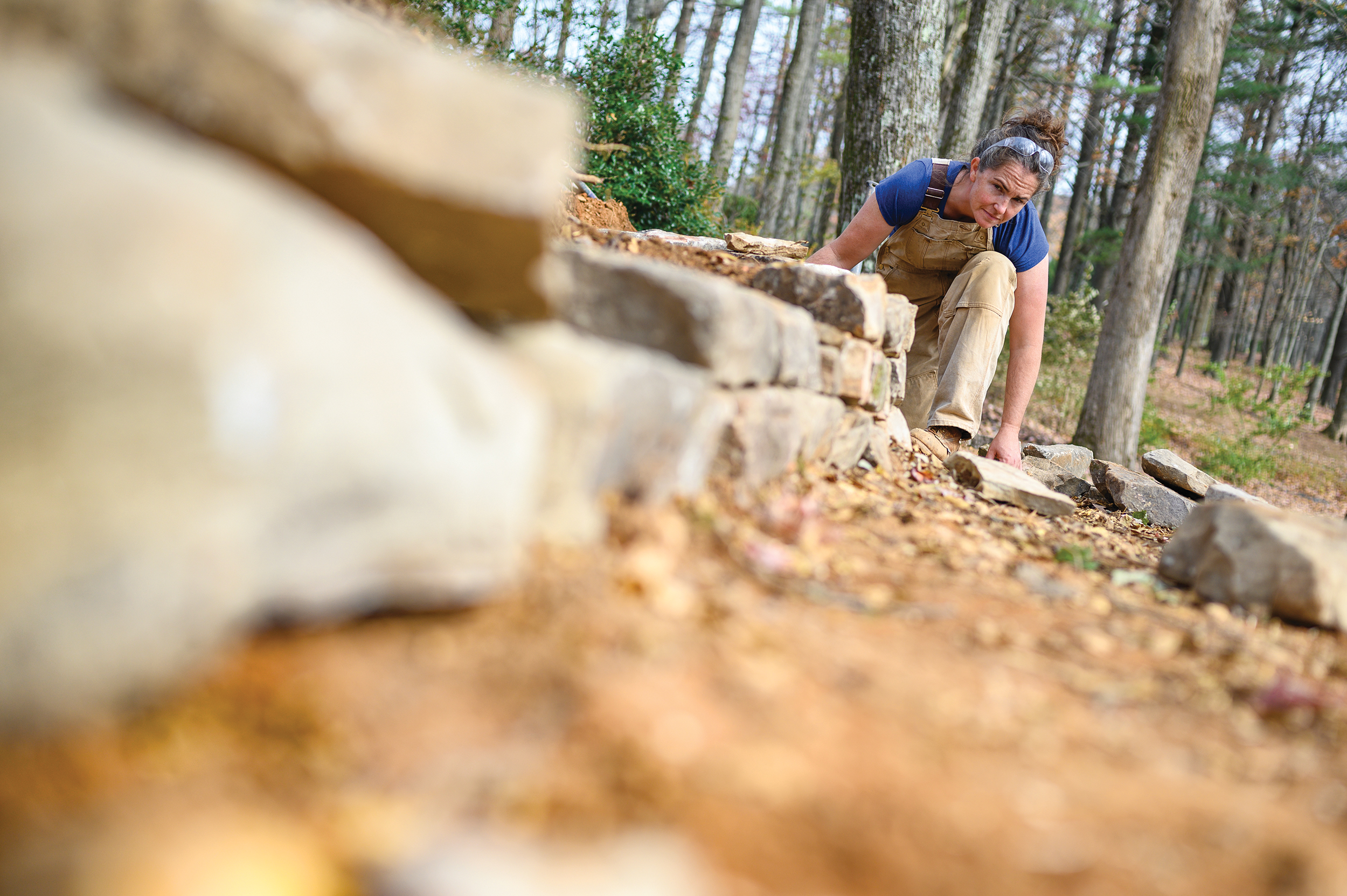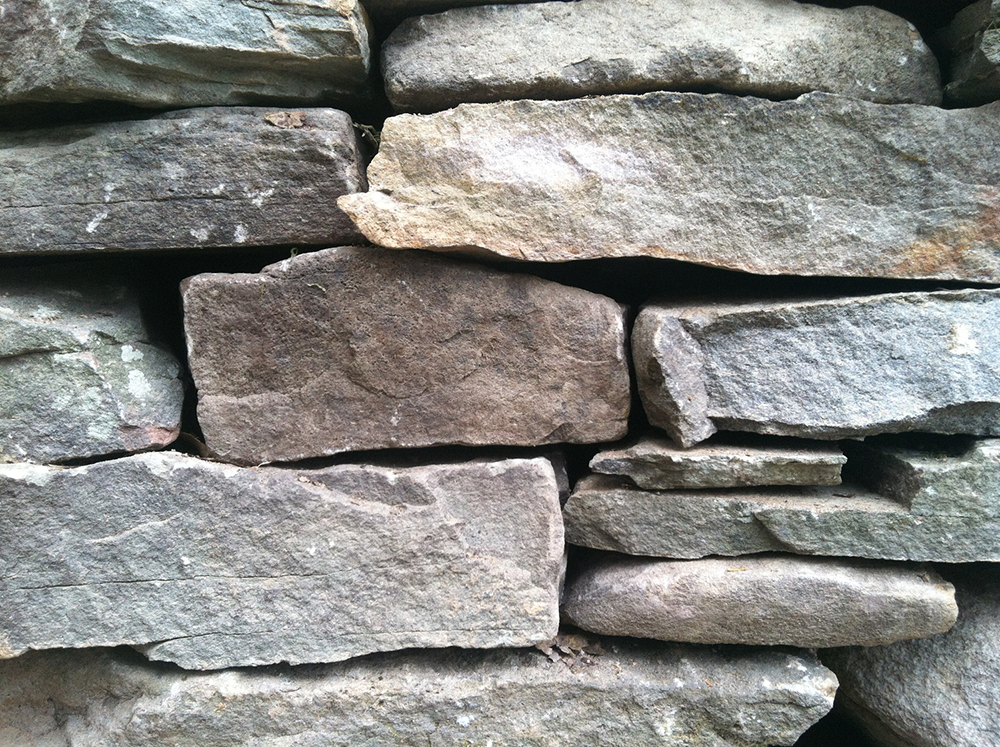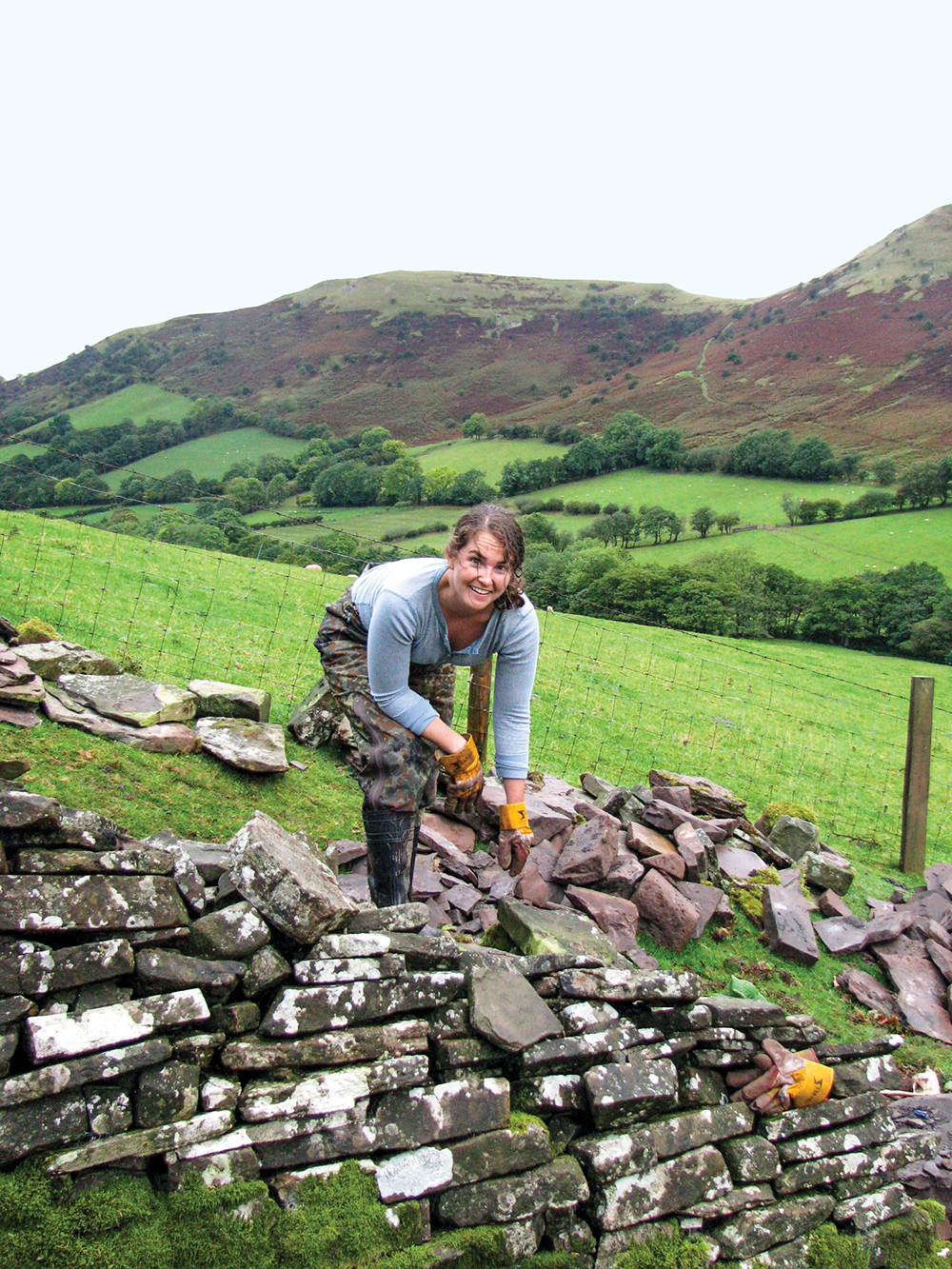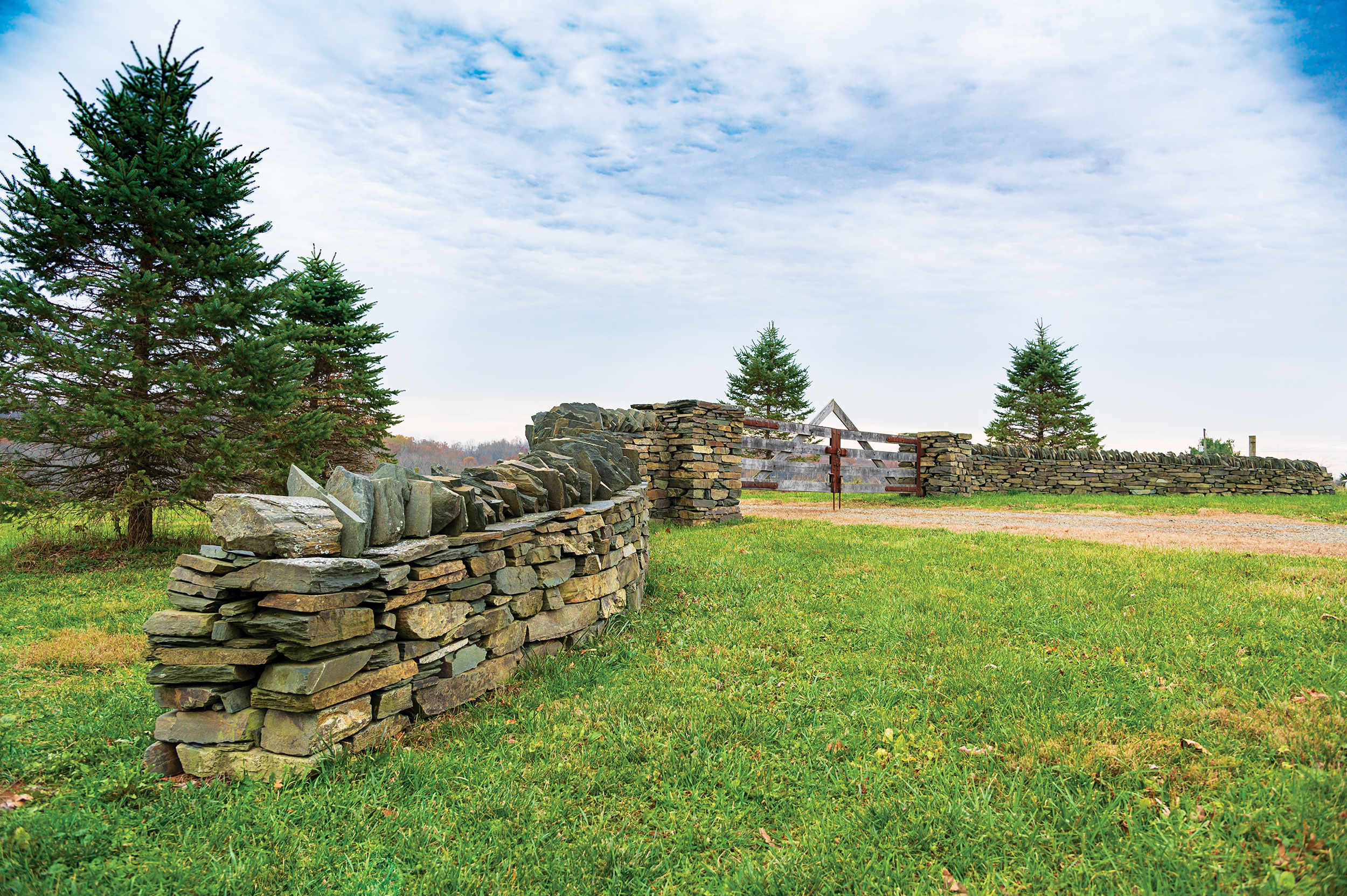A Perfect Fit
Posted on Jan. 14, 2020
Brown turned down a promising job with the Smithsonian Institution — one that she had networked for years to get — and ran off to Wales to learn the ancient art of building dry-stone walls. (Grant Halverson ’93)
Whitney Brown ’10 grew up playing by the rules. Then she imagined the useful art a perfectionist might create if she bent them.
by Elizabeth Leland ’76
Acting on an impulse, Whitney Brown ’10 (MA) changed the course of her life.
A Phi Beta Kappa perfectionist, intent on a career studying folklore, Brown turned down a promising job with the Smithsonian Institution — one that she had networked for years to get — and ran off to Wales to learn the ancient art of building dry-stone walls.
Stone by stone, with her hands as her tools, she helped restore a crumbling 200-year-old farm boundary wall out in the rugged Welsh countryside. Howling wind and blinding rain lashed her face. Mud splattered her clothes. Stones strained her back and smashed her fingers.
As she muscled through the heavy lifting and wretched weather day after day, week after week, Brown felt empowered. And — in an unexpected way — she felt relaxed.
“For me, building a wall is meditative,” she said. “It grounds me and refocuses me, and all the mess of the world falls away. I miss it when I don’t do it.”
Her early years of “walling” in Wales brought Brown great joy and profound heartbreak, which she chronicled in Between Stone and Sky, a deeply revealing memoir about her apprenticeship with an older man and the self-awareness and emotional struggles that came with it.
Now, 10 years after she hefted her first stone, Brown stands out as a bit of a curiosity in two far-flung corners of the globe. Residents of central Wales recognize her as “the lady waller.” In the Blue Ridge Mountains, where she owns a house in the Meadows of Dan community, she’s been called “the best-looking stone mason in Virginia.”
Early one afternoon, after a horseback ride on a friend’s Tennessee Walker, she nursed a glass of Grüner Veltliner wine on the porch of her weathered white farmhouse and reflected on her unorthodox journey. She wore cutoff jeans and a green button-down shirt, no shoes. Her hair, brown with streaks of gray, was wet from a shower and piled on top of her head.
Before her stretched a tangle of wild meadow, deep summer greens with sprays of white daisies and Queen Anne’s lace. A stream burbled nearby as storm clouds threatened in the distance.
“I live in a magical place.”
“We try to use a stone mostly as it comes. We don’t cut it, at least not the way I was taught. You might use a hammer to chip off an awkward lump, but that’s all. The skill is understanding how to make a whole out of different shapes.”
— Whitney Brown ’10 (MA)
Even as she spoke the words, in her distinctive deep-throated Southern accent, she also was thinking of a windswept countryside nearly 4,000 miles away. “This is the closest thing to Wales I could find.”
Brown looks built for manual labor — all 5 feet 11 inches strong and muscular. But she was not brought up for it. Raised in upstate South Carolina, she describes her family as “lower middle class.” Her mother worked as a school secretary, her father as a draftsman and, later, as a project manager for engineering firms. They envisioned a more lucrative, white-collar future for their daughter, a first-generation graduate of the University of Alabama.
“I had played by the rules,” Brown wrote in her memoir. “A+ student, valedictorian, ‘Most Likely to Succeed,’ Phi Beta Kappa, Dean’s List, summa cum laude, et cetera. … I always played it safe, and I was terrified of imperfection.”
Meeting Jack
While working on her master’s in folklore at Carolina, she quit playing by the rules.
It was summer 2009. Brown took a job as supply coordinator with the Smithsonian Folklife Festival, an annual exhibit on the Washington Mall showcasing international culture. It was a menial job, schlepping supplies to participants, but one she hoped would lead to a position as a curator.
That summer, one of the festival’s programs featured Wales. One of the artisans was a master waller, and his craft and personality intrigued her. In her memoir, she calls him Jack. He was 33 years older than Brown, who was 26. When the festival ended, and much to her parents’ dismay, she accepted his invitation to visit Wales and learn the art of building dry-stone walls.

Brown shows off a boundary wall between a family farm, where’s she’s standing, and Brecon Beacons National Park near Pengenffordd in Wales. “It’s the first wall I ever helped rebuild on my initial trip to Wales in 2009, and I’m revisiting it in far less muddy conditions in 2015. It was a very sweet moment. After a few years of grass growing, it looks like no one touched it.” (Courtesy of Whitney Brown ’10)
She said she longed to be the person doing something, not writing about the person doing something.
“I had wound up existing in an existential black hole of smartphones and graduate research that began to feel irrelevant. For the first time in my life, somebody offered me a job with my hands. After working in Davis Library so long, trying to finish my thesis, there was an ocean of green in Wales — just me and the guy teaching me. Otherwise, just sheep and cattle and birds. It was so peaceful, just 180 degrees opposite of what my life had been.”
Unlike most masons who build “wet walls” by setting stones in mortar, they relied on gravity and friction to hold their dry-stone walls together. It’s a technique passed down over thousands of years in rural communities around the world, from New England to New Zealand.
(The dry-stone walls on and near Carolina’s campus have roots in New England, where the legendary professor Elisha Mitchell grew up. In 1838, with the blessing of President David L. Swain, of the class of 1825, Mitchell directed his work crew, who were enslaved, to begin stacking the stones into walls. They used no mortar, finding ways to lock the rounded shapes into a solid, pleasing whole. Remnants of those oldest walls remain today, visible along the arboretum border flanking Raleigh Road and along portions of the old Chapel Hill Cemetery. The old walls around the James Love House on Franklin Street, which houses the Center for the Study of the American South, form a particular memory for Whitney Brown. “A lot of my happiest memories from grad school are neatly framed by those old walls,” she said.
(Some of those walls have fallen into disrepair, a sight not lost on Brown — she has offered to do the rehab. “I hope the University knows who to call now,” she said.)

(Grant Halverson ’93)
Brown and her mentor interlocked stones in level horizontal layers. At each joint where the stones came together, they “bridged” the gap with a stone above so the joints on different levels didn’t align. If there were gaps between stones in the wall’s interior, they filled them as tightly as possible with smaller stones, called hearting. They lined the top of the wall with heavy “cope stones” to hold down the layers of stones below and to shed rainwater.
“We try to use a stone mostly as it comes,” Brown said. “We don’t cut it, at least not the way I was taught. You might use a hammer to chip off an awkward lump, but that’s all. The skill is understanding how to make a whole out of different shapes. It’s a mastery of physics.”
During that first visit to Wales, Brown began to rethink what she wanted out of life. “Sometimes you don’t know what you need until you try something else,” she said. “There was something about working with stone that had been there for so long. It was so therapeutic, it just shifted me into a different gear.”
Back in the States, she plotted her return. By day, she worked at a bakery. By night, she worked on her thesis, “From Cotton Mill to Co-op: The Rise of a Local Food Culture in Carrboro, North Carolina.” In an article published in the journal Southern Cultures, adapted from her research, she easily could have been writing about herself:
“There is a visible contingent that seems to believe that newer is not always better, and that older, more traditional ways have their advantages. Whether ‘old’ means a more sustainable way of doing things, a more personal one, or a way somehow more authentic and meaningful, many young people are turning to the past. Their motivations were many, but by and large they sought the authenticity of greener landscapes, more room to breathe, music of grit and substance, and a true and lasting relationship with the land itself.”

Brown strips out an old wall at Talgarth, Wales, to prepare for restoration. “For me, building a wall is meditative,” she said. “It grounds me and refocuses me, and all the mess of the world falls away.” (Courtesy Whitney Brown ’10)
Brown craved the outdoors and the physical challenge of manual labor — with its silent moments and the satisfaction of having created something tangible — as much as she desired an intellectual challenge. Having both gave her balance.
After she completed a draft of her thesis, she turned down the Smithsonian job — historical researcher for an exhibition — and escaped back to the hills of Wales.She fell in love with the labor, the land and — after three years — with the man who taught her.
“Miss Whitney Brownstone,” he affectionately called her. According to Brown’s memoir, he also once told her: “Darling, you are one of the most highly strung, opinionated women I have ever known. I’m not saying that’s a bad thing, but you are unusual.”
One wall leads to another
Brown is as comfortable slogging outdoors in Carhartt overalls and steel-toed boots as she is wearing a skin-tight hot-pink silk dress and 4-inch snakeskin heels for an evening out. She throws about cuss words with as much abandon as she defers to elders with a “Yes, ma’am” and “No, sir.” Like Brown, her little house in the mountains is a contradiction. A chop saw in what was supposed to be her yoga studio. A KitchenAid mixer in an antiquated kitchen. On her coffee table, Istanbul: A Tale of Three Cities beside The Gingerbread Man and The Lumbee Indians and The Adventures of Maud West.
Angharad Jones, a Welsh blacksmith, met Brown at the 2009 Smithsonian festival and has been struck by her ease at moving between intellectual and manual pursuits. “She can turn a phrase as well as she can build a wall,” Jones said. “It’s the fusion of the two crafts that merge so beautifully in her book and reminds us that you can be both eloquent and practical.”
For seven years, Brown juggled a peripatetic life between the United States, where she survived on farm work and construction and a few garden walls, and Wales, where she labored beside Jack. She wanted to marry him; she said he didn’t. The “lady waller” and her mentor no longer keep in touch.

The completed gateway wall in Virginia – the one Brown calls her most beautiful and her most challenging. (Grant Halverson ’93)
In Virginia, one wall led to another by word of mouth. The most challenging involved a curving, undulating construction with a formal columned gateway. The most beautiful wall she ever designed. The most difficult to build. It was so difficult, she sprayed expensive perfume under her overalls each morning to lift her spirits. She endured weeks of subfreezing temperatures, lifting stones, sorting through the jigsaw puzzle of how they should interconnect, all the while questioning whether she could pull off the stunning design.
She nailed it. But afterward, physically exhausted and uncertain of what came next, she retreated to her childhood bedroom in Greenville, S.C. There, in the safety of her parents’ home, she succumbed to a brief bout of depression.
She said she is now “reclaiming” her way with the help of her farmhouse, which she bought in 2017. She watches fireflies at dusk. Drinks water from a spring. Marks the seasons, from the first small bloom of trillium to the large burst of flame azalea. And she contemplates her next step.
Building the occasional wall doesn’t pay her mortgage or for repairs. She supports herself with construction work, splitting her time between Durham and the mountains. In July, she joined the advisory board of the Blue Ridge Parkway Foundation. In August, she taught a two-day course at Black Mountains College in Wales on repairing walls.
One day, she no longer will be able to do the heavy lifting that walling requires, up to three or four tons of stone in a day. “It’s amazing what you can do with your body, how much you can achieve,” she said. “But you need to rest your body. I’m 36 and have a mounting level of spinal arthritis.”
When the time comes to quit, Brown said she may seek out the curating job she once coveted. Her immediate dream is to write a second book. She already has a topic, born from her experience sailing off Milford Haven in Wales.

Brown, down in the dirt for a modern wall in Virginia. She has offered her services on some of the old walls on the Chapel Hill campus. (Grant Halverson ’93)
“It has to do with navigation,” Brown explained. “I was listening to a story on NPR about the cognitive science behind navigation in the age of GPS, about learning to navigate and be lost and not know exactly where you are. It would be a multifaceted look at navigation. I’m interested in sextants and stars. It would be a chance to travel and do research.”
Jim Newlin ’69 (’71 MRP) and Silvie Granatelli chose Brown to build a low “sitting wall” around their patio because of her artistry and the fact that she is a woman excelling in a traditionally male profession. They became friends during the weeks she worked on the wall — her first in Virginia — and Brown ended up buying the 108-year-old farmhouse next door.
“She probably could do anything she sets her mind to,” Newlin said, ticking off some of Brown’s accomplishments. Building walls. Sailing. Writing. Farming. Operating heavy equipment. It was Newlin who recommended her practical skills for service on the Blue Ridge Parkway Foundation advisory board.

Completed cobbles in Gilfach, Wales. When the time comes to quit the physically demanding work, she may seek the curating job she once coveted. (Courtesy Whitney Brown ’10)
Standing before the wall one afternoon, Brown appraised her craftsmanship. She recalled her anxiety before launching into every project. The physical agony while working. The hammers thrown in frustration, the stones flung. And then, when each wall was finally finished, the moment she looked up and recognized the beauty of her creation. A living history.
“I think walling in a sense was sent to teach me things I need. I am absolutely not a patient person. I very easily get frustrated with myself. I tend to be very angry if I can’t figure out something in an appropriate amount of time. Building a wall is a slow process. You can’t hurry it. Sometimes you have one little hole on a level you need to fill before you go on, or a complicated joint, and you can’t go on until you find the right stone.”
In life, as in walling, Whitney Brown is searching for the perfect fit.
Elizabeth Leland ’76 is a freelance writer based in Charlotte.
Thanks for reading the Carolina Alumni Review
Carolina Alumni members, sign in to continue reading.
Not yet a member? Become one today.
